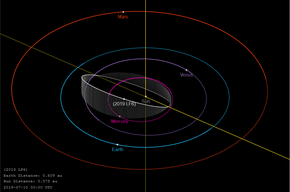|
2019 LF6
2019 LF6 is a near-Earth object of the Atira group. After 2021 PH27, it has the second-smallest semi-major axis among the known asteroids (0.555 AU), beating the previously-held record of 2019 AQ3.[3][4] It orbits the Sun in 151 days.[2] Discovered at only 19th magnitude, it is very difficult to see, never getting far from the sun and twilight.[5] It only occasionally brightens above 16th magnitude. Discovery was made using the Zwicky Transient Facility.[6] 2019 LF6 orbits the Sun at a distance of 0.3–0.8 AU once every 5 months (151 days; semi-major axis of 0.56 AU). Its orbit has an eccentricity of 0.43 and an unusually high[6] inclination of 30° with respect to the ecliptic.[2] The asteroids 594913 ꞌAylóꞌchaxnim and 2019 AQ3 are the only known asteroids with closer aphelions. The orbital evolution of 2019 AQ3 is similar to that of 2019 LF6.[7] References
External links
|
||||||||||||||||||||||||||||||||||||||||||||||||||||||
Portal di Ensiklopedia Dunia
